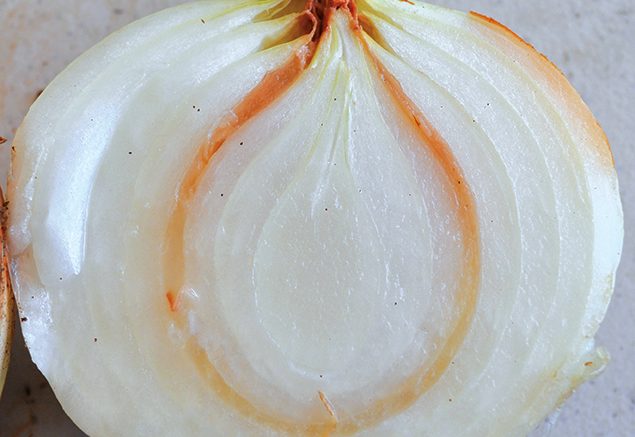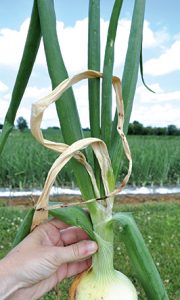By Michael Larose, Agrichemical Segment Manager, BioSafe Systems
Ask an onion grower what he fears most, and he will probably tell you a bacterial rot outbreak in his fields. There are few things worse than an exhausting season of blood, sweat and countless hours of tending to and growing a beautiful stand of onions, only to find it decimated by disease. Bacterial rot can strike just before harvest, during harvest, or in transit or storage; it does not discriminate.
Onion growers across the United States are part of a tightly knit network and have shared their stories about bacterial “plagues” that have decimated localized onion production areas and destroyed 60 to 90 percent of a once-flourishing crop. The hardest hit regions of the United States are, by far, the Northeast, Mid-Atlantic and Southeastern states, where a favorable summer climate creates a hotbed for bacterial growth.
With limited labeled solutions to combat bacterial pathogens on onions, growers have rapidly been educating themselves and adopting new technologies such as bio-chemicals and biologicals as part of an integrated pest management (IPM) program to reduce overall outbreak incidence and severity. Applying changes to an established program to favor a preventative approach, rather than a reactive one, can reduce bacterial inoculum to negligible levels, creating a further reduction of loss.
Need for New Tools
There’s a thought that tends to take root in the agricultural community: “I’ve been using the same spray program for years, and all it does is help me sleep at night. I have no idea if it’s really working.” For the past five to six years, there has been some validity to that thought process. There are very few advancements or new technologies being introduced to combat bacterial rot, especially when it comes to bactericides to help the onion industry compared to the tremendous funds allocated to other crops with bacterial susceptibility.
Onion growers have relied on centuries-old solutions, including standard applications of copper and sulfur sprays, which many university research studies have proven contribute to the mutational resistance issues with similar treatments. To combat this growing resistance, bio-pesticide manufacturers are providing growers with innovative tools that work synergistically with growers’ standard programs.
Peroxyacetic acid (PAA) is a bio-chemical, yet a lethal tool in bacterial pathogen control for onion, shallot and garlic crops. Over the past 20 years, peroxyacetic acid’s use as a foliar bactericide/fungicide for conventional fruit and vegetable crops has increased tremendously. Through continued research and development, innovative formulations have been developed for soil treatment programs targeting root rot pathogens, irrigation water treatment for coliform reduction and food safety solutions that address challenges in controlling human health pathogens. This includes packing house solutions related to recirculated water, spray bar applications and hydro-cooler treatments to improve the overall quality and shelf-life of crops that are prepared for consumption.
Peroxyacetic acid, when formulated and engineered to ensure optimized formulations for specific uses, provides a rapid oxidative reaction against bacterial and fungal cells within minutes of contact. Utilizing a non-ionic surfactant with chemistries such as PAA can increase effectiveness in high-pressure scenarios or when used in thick canopy crops.
Bacterial Infection Management
Many bacterial pathogens affect onions, with most causing center rot or bulb surface rot near harvest, during storage or in transit. Bacterial diseases of onions have been a limiting constraint on the fresh-market onion yield and quality for decades. In recent years, growers have seen a dramatic increase in losses due to pathogen resistance and weather abnormalities. In fact, onion crop loss caused by bacterial pathogens has surpassed the amount of loss due to fungal pathogens, insects or weed competition.
As with any pathogen outbreak, there is no cure-all chemistry that will solve bacterial pathogen issues in onions; however, incorporating a year-round IPM strategy to manage the level of bacterial infection in the field dramatically improves the efficacy in a grower’s program.
Recent Pennsylvania State University research found that a significant percentage of bacterial inoculum originates from transplants and weeds. Combating this by maintaining a strong herbicide program through the season will help reduce harboring points. Similarly, ensuring transplants are sprayed with a bio-chemical product before planting will help reduce any existing inoculum to prevent it from entering the field.
The use of biologicals and bio-stimulants in a production program to help with numerous pathogen, pest and plant stress challenges should be the new norm among onion growers.



